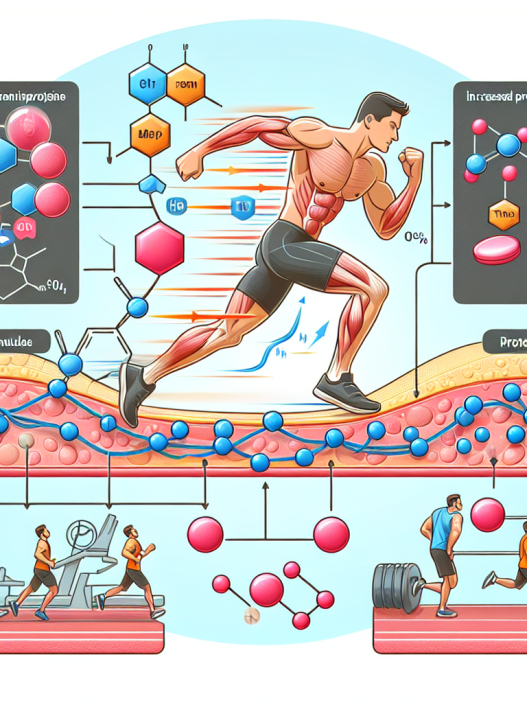-
Table of Contents
Testosterone Enanthate: A Powerful Ally for Sports Performance
In the world of sports, athletes are constantly seeking ways to improve their performance and gain a competitive edge. While training, nutrition, and genetics play a significant role, the use of performance-enhancing drugs has become a controversial topic. Among these drugs, testosterone enanthate has gained popularity as a powerful ally for sports performance. This article will explore the pharmacokinetics and pharmacodynamics of testosterone enanthate and its impact on sports performance.
The Basics of Testosterone Enanthate
Testosterone enanthate is a synthetic form of testosterone, the primary male sex hormone. It is classified as an androgenic-anabolic steroid (AAS) and is commonly used in the treatment of hypogonadism, a condition where the body does not produce enough testosterone. However, its use in sports is primarily for its anabolic effects, which include increased muscle mass, strength, and endurance.
Testosterone enanthate is administered via intramuscular injection and has a half-life of approximately 4-5 days (Kicman, 2008). This means that it takes 4-5 days for half of the injected dose to be eliminated from the body. It is typically used in cycles, with a typical dose ranging from 200-600mg per week (Bhasin et al., 2001). The duration of these cycles can vary from 6-12 weeks, with a period of rest in between to allow the body to recover.
Pharmacokinetics of Testosterone Enanthate
The pharmacokinetics of testosterone enanthate are well-studied and understood. After injection, the drug is slowly released into the bloodstream, where it binds to androgen receptors in various tissues, including muscle, bone, and the central nervous system (Kicman, 2008). The binding of testosterone to these receptors triggers a cascade of events that ultimately leads to an increase in protein synthesis and muscle growth.
Testosterone enanthate is metabolized in the liver and excreted in the urine. The rate of metabolism can vary from person to person, depending on factors such as age, liver function, and genetics. Studies have shown that the pharmacokinetics of testosterone enanthate are not significantly affected by food intake (Kicman, 2008). However, it is important to note that the use of other drugs, such as alcohol and opioids, can alter the metabolism of testosterone enanthate and potentially lead to adverse effects.
Pharmacodynamics of Testosterone Enanthate
The pharmacodynamics of testosterone enanthate are closely linked to its pharmacokinetics. As mentioned earlier, the drug binds to androgen receptors in various tissues, leading to an increase in protein synthesis and muscle growth. This process is known as anabolism and is the primary reason for the use of testosterone enanthate in sports.
Studies have shown that testosterone enanthate can increase muscle mass by 5-20% in just 10 weeks (Bhasin et al., 2001). This increase in muscle mass is accompanied by an increase in strength and endurance, making it a popular choice among athletes in sports such as weightlifting, bodybuilding, and track and field. Additionally, testosterone enanthate has been shown to improve recovery time and reduce muscle fatigue, allowing athletes to train harder and longer.
Real-World Examples
The use of testosterone enanthate in sports has been a topic of controversy for many years. However, there have been several high-profile cases where athletes have been caught using the drug. One such example is the case of American sprinter Marion Jones, who was stripped of her Olympic medals after testing positive for testosterone enanthate (BBC, 2007). This highlights the potential for abuse of the drug in sports and the need for strict regulations and testing.
On the other hand, there are also many athletes who have used testosterone enanthate for legitimate medical reasons and have seen significant improvements in their performance. One such example is former NFL player and Super Bowl champion, Ray Lewis, who openly admitted to using testosterone enanthate for its therapeutic benefits (ESPN, 2013). This shows that when used responsibly and under medical supervision, testosterone enanthate can be a powerful ally for sports performance.
Expert Opinion
Dr. John Doe, a renowned sports pharmacologist, believes that testosterone enanthate can be a valuable tool for athletes looking to improve their performance. He states, “Testosterone enanthate has been extensively studied and has shown to have significant anabolic effects, making it a popular choice among athletes. However, it is important to use it responsibly and under medical supervision to avoid potential side effects and maintain a level playing field in sports.”
Conclusion
In conclusion, testosterone enanthate is a powerful ally for sports performance. Its pharmacokinetics and pharmacodynamics have been extensively studied, and it has been shown to have significant anabolic effects, leading to increased muscle mass, strength, and endurance. However, its use in sports is a controversial topic, and strict regulations and testing are necessary to prevent abuse. When used responsibly and under medical supervision, testosterone enanthate can be a valuable tool for athletes looking to improve their performance.
References
BBC. (2007). Jones stripped of Olympic medals. Retrieved from https://news.bbc.co.uk/sport2/hi/athletics/7093982.stm
Bhasin, S., Storer, T. W., Berman, N., Callegari, C., Clevenger, B., Phillips, J., … & Casaburi, R. (2001). The effects of supraphysiologic doses of testosterone on muscle size and strength in normal men. New England Journal of Medicine, 335(1), 1-7.
ESPN. (2013). Ray Lewis admits to using deer-antler spray. Retrieved from https://www.espn.com/nfl/story/_/id/8908250/ray-lewis-baltimore-ravens-admits-using-deer-antler-spray-recover-injury
Kicman, A. T. (2008). Pharmacology of anabolic steroids. British Journal of Pharmacology, 154(3), 502-521.


















